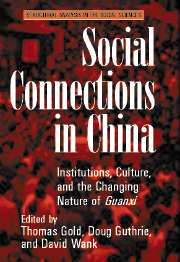Book contents
1 - Practices of Guanxi Production and Practices of Ganqing Avoidance
Published online by Cambridge University Press: 30 July 2009
Summary
The problem of defining guanxi is one that I have dismissed and come back to many times. One can approach it from many angles. Is a definition of guanxi meant to distinguish something Chinese from something non-Chinese? Or is it meant to distinguish one sort of Chinese thing from another sort of Chinese thing? Is guanxi a “thing” at all, or is it just a sort of linguistic abstraction? If the latter, what sort of abstraction is it – a conceptual tool of (English language or Chinese language) social science, or a “native” one? The pairings implied in these questions all oversimplify. What we today call China has interacted with other parts of the world for so long that it is not possible to strictly differentiate the Chinese from the non-Chinese; linguistic abstractions are “things” that have extra-linguistic effects; “native” and social scientific conceptual abstractions usually interact dialectically. I list these questions at the start to point out that discussions of what guanxi are, or about how to approach the study of guanxi, often falter because those involved focus on different combinations of those questions. One person discusses the uses of guanxi as a theoretical tool in the social sciences (e.g., Hwang 1987), while another discusses whether Chinese guanxi and American business networks really differ that sharply (e.g., Guthrie 1998a).
Reviewing my own writings on guanxi (Kipnis 1994a, 1996, 1997), I find that I have mostly tried to avoid these questions, precisely because I do find them oversimplistic.
- Type
- Chapter
- Information
- Social Connections in ChinaInstitutions, Culture, and the Changing Nature of Guanxi, pp. 21 - 34Publisher: Cambridge University PressPrint publication year: 2002
- 28
- Cited by



